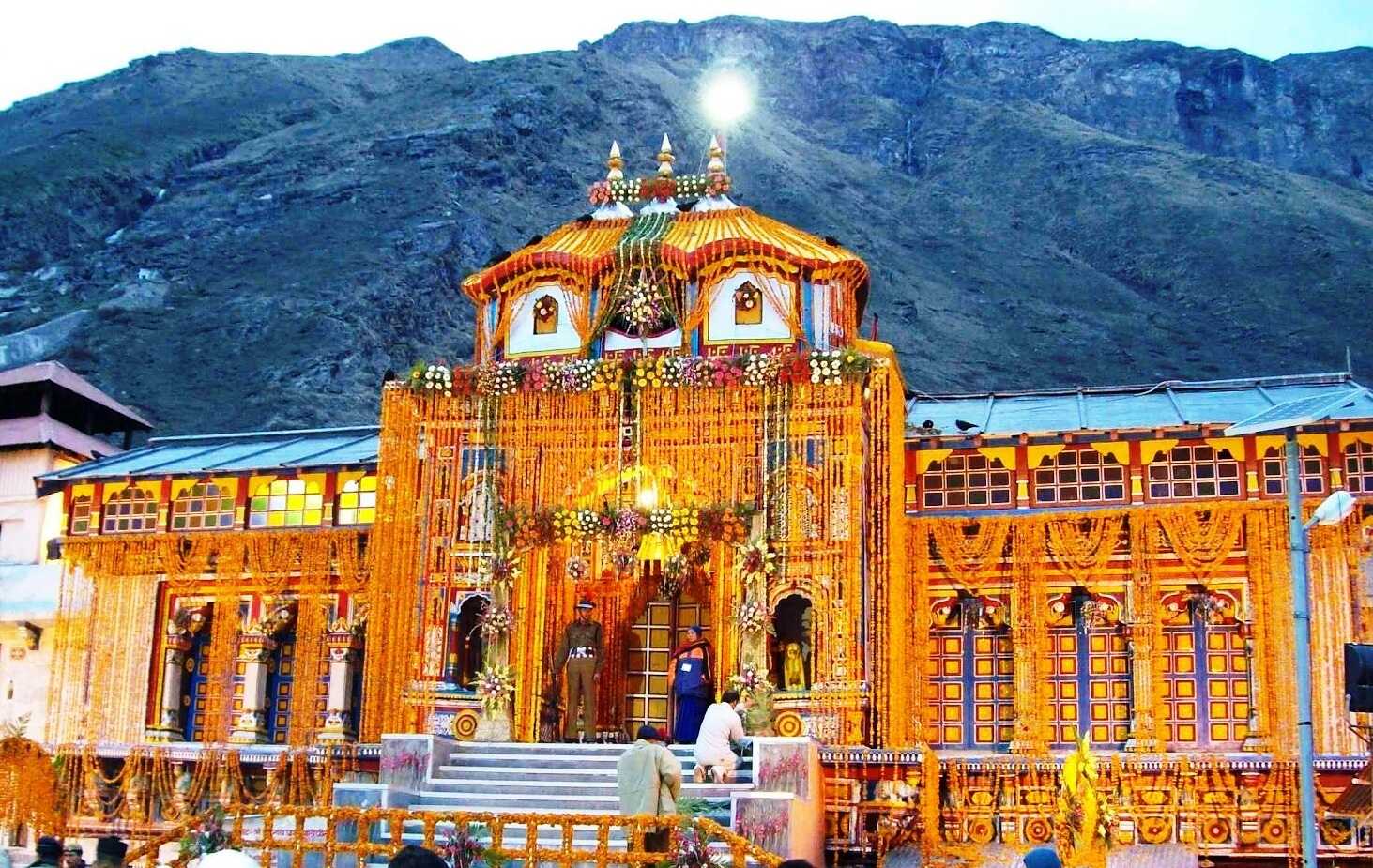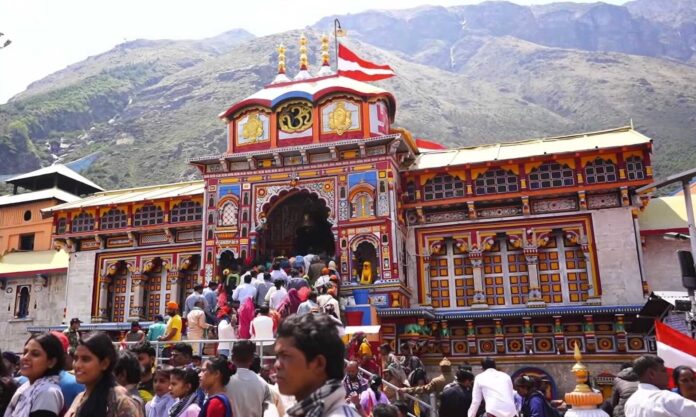In this article, we will talk about the major Information About Badrinath Temple. First of all, Badrinath is one of four pilgrimage sites which is situated in the northern direction of India.
Information about Badrinath Temple

Badrinath Temple is the only temple that is part of both the Char Dhams of India and the Chota Char Dhams of Uttarakhand.
- Char Dhams of India: Badrinath, Dwarka, Puri, and Rameswaram
- Chota Char Dhams of Uttarakhand: Badrinath, Kedarnath, Gangotri, and Yamunotri
Badrinath also known as Badrinarayana Temple is a Hindu Temple dedicated to Lord Vishnu. It is located in Garhwal hill tracts along the banks of the Maa Alaknanda River in Chamoli District in Uttarakhand, India.
The Badrinath town is located at a height of 3,133 m (10,279 ft) above sea level.
The Nar Parvat (Nar Hill) is located opposite the Badrinath temple, while the Narayana Parvat (Narayan Hill) is located behind the Neelkanth Peak.
Importance of Badrinath Temple
There is a lot of information about the Badrinath temple in the Vedas and Puranas.
According to some sources, the area of Shri Badrinath (Badrikashram) recognized as Astam Baikuntha in the universe is the one that is presided over by Lord Vishnu himself.
The Dham of Satyug is Badrinath, Rameshwaram of Treta, Dwarka of Dwapar, and Jagganathpuri have been recognized in Kaliyuga.
This ashram (Badrikashram) of Lord Nar-Narayan has been an important center of Vedic culture since ancient times.
Due to its beautiful and rich surroundings, this Area of the middle Himalayas was called “Badarikashram” in ancient times. Badrinath has been called by different names in different periods of the universe.
Not only do the devotees of the Hindu religion come to Badrinath Darshan, but people of other religions also come to see this wonderful form of Badrinath.
The milky white River Mandakini with its icy mountains and lush green forests add to the beauty of Badrinath Dham.
Badrinath temple is a center of attraction for millions of pilgrims every year. Therefore thousands of devotees visit the Dham due to its mythological beliefs.
Chota Char Dham Yatra 2023 in Uttarakhand

One of the most important pieces of information about the Badrinath temple is that it is the part of Chota Char Dham Yatra of Uttarakhand along with the Char Dhams of India.
Badrinath is one of the significant temples of the sacred Chota Char Dham Yatra. This Yatra Consist of four temples of Uttarakhand. These are Kedarnath, Badrinath, Gangotri, and Yamunotri.
The popularity of Badrinath and Kedarnath Dham increasing every year. Because of Prime Minister Narendra Modi’s Visit during Yatra Season. And he announced the All-Weather Road package also for public welfare during Election Rally.
All-Weather Road Project work is under construction and it will be completed before Char Dham Yatra 2023.
The Spiritual tour of the Badrinath temple provides immense peace and satisfaction to the devotees. The environment of this mandir always remains divine and purifies the soul. It always rekindles the human being’s belief in the almighty.
Meaning of Badrinath
According to Hindu legend, the god Vishnu sat in meditation at this place. During his meditation, Lord Vishnu was unaware of the cold weather. Goddess Lakshmi, his wife, protected him in the form of the Badri tree.
Pleased by the devotion of Goddess Lakshmi, God Vishnu named the place Badrika Ashram. Hence Goddess Lakshmi was called the “Badri Vishal” as a large Beri/jujube and Lord Vishnu as the “Badrinath” husband of Badri.
- The word “Badrinath” is derived from two words Badri and Nath.
- The meaning of “Badri” is Beri/Jujube which refers to Goddess Laxmi.
- And the meaning of “Nath” is the Lord or Husband which Refers to Lord Vishnu.
- Lord Vishnu is the Husband of Goddess Laxmi so Badrinath refers to Lord Vishnu.
According to Hinduism, people in Sanatan dharma believed that the sacred tour of this holy place opens up doorways to “moksha” or heaven.
History of Char Dham Temples
About Badrinath Pooja Timing
According to the rituals of worship, the doors of the Badrinath temple open at 7 am in the morning.
- First of all, sandalwood paste is removed from the body of Lord Badrinath.
- After that Lord Badrinath is bathed and again decorated with Sandalwood paste, Clothes, and Ornaments.
- After that Lord Badrinath is worshiped and offered Bhog to him.
- After this, the doors of the temple are closed.
- The doors of the temple open again in the evening at 4 o’clock and at 6 o’clock the worship of evening begins.
- And at 9 o’clock in the night, the doors of the temple are closed again.
Inside Structure of Badrinath Temple

The temple of Badrinath is divided into three parts. (i) Singh-dwar, (ii) Mandap, and (iii) Garvagraha.
Lord Badrinath’s Deity in the main Garvgraha, about three and a half feet in Shaligram rock, quadrangle, Padmasan as a form of penance, He is wearing a golden crown with many gems and is adorned with a tilak studded with diamonds in the center of his forehead.
A story is prevalent in relation to the establishment of Badrinath, that once Lord Shankar was traveling to the Himalayas with Mother Parvati. They saw a little child crying in the middle of Badrinath Marg.
Mother Parvati stopped in pity and she lifted the crying child in her lap. That child stopped crying and start smiling and then the child appeared in the four-armed form of Lord Vishnu.
After that Lord Vishnu requested Lord Shiva and Mother Parvati with urgency and said Lord, all this Kedarkhand is your holy Area, so please give shelter to me also under this holy area.
As a result of the consent of Shiva-Parvati, this Badrikashram area became the biggest pilgrimage of Vaishnavism in this Shiva land.
Must Read Amazing Facts
Who Built Badrinath Temple? (Construction)
According to many legends and records, it is believed that the Badrinath temple was rebuilt thousands of years ago by Adi Shankaracharya. The exquisite architecture of Badrinath Mandir is considered to be more than 1000 years old.
According to mythic, it was originally established as a pilgrimage site by Adi guru Shankaracharya in the ninth century to revive the lost prestige of Hinduism.
Shankaracharya excludes the idol of Lord Badrinath from Narad Kund and restored it and established Jyotirmath in the form of Atharvaveda monastery.
In order to protect and propagate Vedic religion, Shankaracharya established his monastery in all four directions of the country near these places of pilgrimage.
Jaggannathpuri in the east, Dwarkapuri in the west, Rameswaram in the south, and Badrikashram (Badrinath) in the north were built under these four dams.
Explore More…
